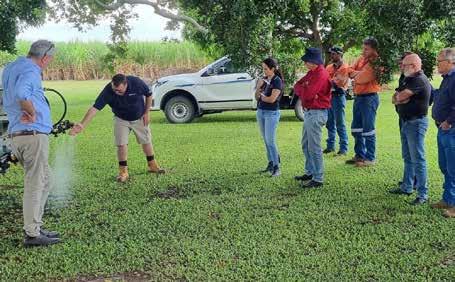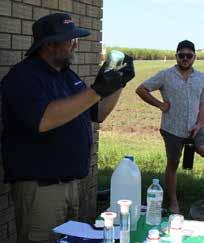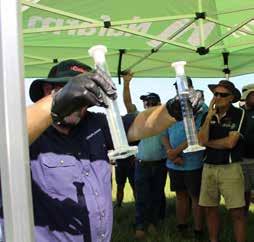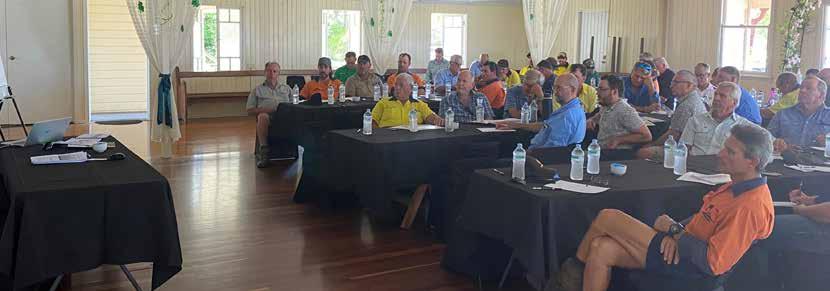
5 minute read
UNDERSTANDING HERBICIDE FAILURES IN WEED CONTROL

Yield loss from weed competition and the cost of weed control in sugarcane are estimated to cost the Australian sugar industry $70 million annually (McMahon et al, 2000).
Advertisement
SRA Weed Scientist Emilie Fillols has been holding Advanced Weed Management Workshops this year to give sugarcane growers an increased understanding of the possible causes of herbicide failures in weed control and herbicide damage to cane. She has been assisted by Nufarm and Croplands’ representatives. More workshops are planned.
The workshops have aimed to optimise herbicide control of weeds and growers’ spend on weed control by increasing knowledge about the correct:

• adjuvant, where required
• droplet size (spray quality)
• weather conditions to avoid spraydrift, and
• speed and pressure rates.
Emilie described the different modes of action used by herbicides to kill plants.
“Herbicides target specific metabolic functions in plant cells – most target the enzymes in the leaves or in the growing points of the plant,” Emilie said.
“Some herbicides mimic hormones and disrupt various processes in the plant.
“Some plants are less affected by herbicide than others because the different features of plants restrict the way the herbicide can get into the plant to reach its target site.
“For example, the thicker the wax is on the ‘skin’ of the plant, the harder it’s going to be for the herbicide to get in.
“When the plant gets stressed, e.g. through moisture stress, that wax becomes more dense. The plant metabolism also slows down.
“It’s just the plant’s normal physiological response but that’s why we always recommend that you don’t spray stressed weeds,” she said.
Some targeted weeds require an adjuvant or oil to improve herbicide penetration through thick wax, and/or on leaves that are hairy, very thin and/or erect.
“The choice of adjuvant should be done in consideration with the herbicide’s properties while following label directions,” Emilie said. “But using it is also likely to enhance penetration through the wax on your cane, so the herbicide is also more likely to get into your crop.”
Another consideration is the location of the growing point in the plant. Broadleaf plants have the growing point at the top of the plant in the leaf. However, in grasses the growing point is located at the bottom.
“Some herbicides do not work well on grasses because they cannot easily move - translocate - from the leaves at the top of the plant down to the bottom where the growing point is,” Emilie explained.
“Some herbicides are selective to some plants – either weeds or crops, which means they can be applied on these plants without triggering significant damage.
“In most cases, the herbicide still gets into the plant via the leaf. However, once in, these plants are able to break down the herbicide before it reaches its target site.
“An example is Blazer®, which is used to kill broadleaf weeds but is ineffective on soybean which can detoxify or break down the herbicide’s molecules.
“In the same way, sugarcane has the capacity to metabolize 2,4-D before it can destroy critical functions in the plant.
“Sugarcane is particularly susceptible to herbicide damage when it’s at the four to six leaf stage in young plant cane,” Emilie said.
“Why? We believe that’s the time when the emerging cane is using all its energy to build its own root system, rather than relying on the sett roots, and it has fewer resources to break down the herbicide,” she said.
To be selective to the crop, herbicides must only be used following label directions.
“The label must be read carefully. A maximum dose might be 4kg/ha. That means at 5kg/ha or 6kg/ha, the spray may affect your crop. There’s a tipping point where the plant no longer has the resources to break down the herbicide.”
The 2,4-D group which includes fluroxypyr, picloram, dicamba and others, targets hormones in the plant. Emilie warned that spraying weeds in sugarcane during the crop’s rapid growth period say, in December or January, could see damage in the form of side shooting, arrows and other strange growths.
“You could use a less selective herbicide in cane so long as you only touched the stems and not the leaves of the crop,” she said. “For this reason, droppers and a directed spray technique such as spot spraying are safest.”
Croplands’ National Sales Manager, Jeremy Rennick, spoke at the workshops about spray drift, describing it as financial loss.

“If you’re not putting the herbicide where you want it you’ve wasted your money.”
Jeremy said that the concept of spray quality had dramatically simplified the process of selecting the right nozzle for a job.
“The Australian Pesticides and Veterinary Medicines Authority (APVMA) created an Australian standard based on the British Crop Protection Council’s - 572.1.
“All droplet sizes are now in microns and nozzles are classified by size, from fine to coarse with very fine and ultra coarse added recently.”
Jeremy spoke about ‘driftable fines’ which are all droplets under 150 microns in size.
“The smaller the droplets you are using, the bigger the risk you have they will be moved off target by the wind or inversions – where a warm layer of air has trapped your spray between layers of colder air.”
It is now a simple process for growers to look up a spray quality chart for the nozzle the operator is using and match it to the label requirements.
“That doesn’t mean to say that if you’re spraying with a coarse spray quality you won’t get any drift,” Jeremy said.
“There’s no such thing as no drift. Even an Airmix nozzle at 3 bar, where the spray quality is coarse, will produce just under 10 per cent drift. At the other end of the spectrum are the XRs, with 45-50 per cent drift at 3 bar pressure.”
Jeremy warned that the regulatory authorities had tackled off target movement of pesticides such as 2,4-D by changing the nozzle requirement from coarse up to very coarse to cut the risk of driftable fines in half.
“Spray quality will change if speed and pressure are increased,” he said.
“So at 3 bar your spray quality might be coarse, but if the pressure is increased to 4 bar the result will be medium spray quality. If you have an automatic rate controller and increase your speed, the ARC will increase the pressure and result in more drift risk.
Jeremy gave some rules of thumb when working out which nozzle was needed. What’s the target? The bigger the target the coarser the spray quality should be.
What’s the type of chemistry you’re using? For systemic action, use bigger spray droplets. For a contact herbicide like paraquat – choose a finer spray quality to increase coverage.
As the risk of spraydrift increases so should your spray quality get coarser.
Pressure: The higher the pressure, the more spraydrift will be created.
Boom height: the higher the release height of the nozzle, the higher the risk of spraydrift.
Weather: spray in unstable air conditions with a regular breeze of about 11 km/ hr - the warm rising air will mix with the cold air in the atmosphere. The riskiest time to spray is in still conditions in the early morning at sunrise when inversion layers occur.
Check your nozzle’s spray coverage with UV dyes or by using water sensitive paper.








